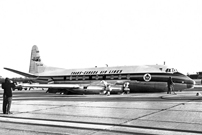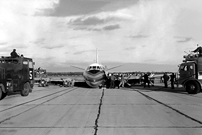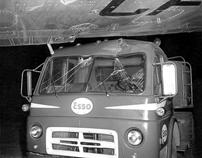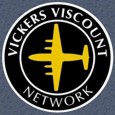
March 1958 to June 1964
Trans-Canada Air Lines (TCA)
CF-THV - c/n 304 - a V.757 series Viscount
Canada registered
May 1957
An order was placed by Trans-Canada Air Lines (TCA) for a fifth batch of thirteen Type 757 aircraft as a follow on from the previous Type 724 and Type 757 orders.
This was the twenty fifth one built.
The total order for Type 757 aircraft reached thirty six in May 1957.
Production Order No. F25/757. Sales Order No. F25/76B. Stock Order No………
13 March 1958
First flight from Hurn Airport, Bournemouth, Hampshire, England.
It was fitted with Rolls-Royce Dart RDa3 Mark 506 engines.
17 March 1958
Aircraft passed off by TCA inspectors as completed and ready for delivery.
It was painted in the later 'white top' livery.
21 March 1958
Departed from Hurn Airport, Bournemouth, Hampshire, England on delivery to Trans-Canada Air Lines (TCA) with fleet number '640'.
After refuelling at Prestwick Airport, Ayrshire, Scotland it continued on to Keflavik Airport, Iceland (742 nautical miles), Bluie West 8 (BW8) Airfield, Sondre Stromfjord, Western Greenland (804 nautical miles), Goose Bay Airport, Newfoundland & Labrador, Canada (872 nautical miles) where it stopped overnight.
BW8 was built during WWII to assist the transfer of military aircraft from North America to Europe and was opened in October 1941.
22 March 1958
Departed from Goose Bay Airport, Newfoundland & Labrador, Canada to Dorval International Airport, Montreal, Province of Quebec, Canada (810 nautical miles).
The cabin seating was installed in Canada, as the seats used by TCA were of American manufacture.
The cabin was fitted out with 44 seats which was a reduction from the original 48 seat specification and provided more leg room.
This was heavily marketed and resulted in a high load factor compared to the 18 seat Douglas DC-3 that it replaced on some routes.

Made an emergency
belly landing
11 October 1959
During Flight 307-11 from Malton Airport, Toronto, Ontario, Canada the aircraft suffered an undercarriage malfunction and made an emergency belly landing at Naval Air Station Glenview, Chicago, Illinois, USA.
After the undercarriage was selected at 15:20 (local) on approach to runway 27R at Midway Airport, Chicago, Illinois, USA Captain Cyril (Cy) M Thomson, a wartime Spitfire pilot and First Officer Russell E (John) Kellythorne noticed that the port main safe green light was not illuminated. They aborted the landing, advised the tower of their difficulties and spent time away from the airport trying to cycle the undercarriage but with no change in their condition. A low flyby over Midway tower confirmed that the port undercarriage leg was not down and that the undercarriage doors were still closed. Capital Airlines ground engineers offered advice through the tower frequency but with no improvement. Whilst the aircraft was circling the cabin crew advised the passengers that it was due to heavy traffic at Midway, so as not to alarm anyone until it was really necessary.
Officials at Naval Air Station Glenview, who were notified of the situation offered to foam their 5091 feet runway 27 for a distance of 1500 feet, starting 500 feet from the easterly threshold which was gratefully accepted by the TCA crew. This prevented the Midway runway from being blocked as it was a busy airport compared to Glenview. The passengers were notifed by First Officer Kellythorne that an emergency landing would take place and everyone remained calm. They continued circling Glenview Naval Air Station and the passengers got a good view of the runway being foamed. All the overhead racks were emptied and the six emergency exit windows were removed at 1000 feet as the aircraft lined up for landing.

Navy fire tenders were
immediately in attendance
At 16:25 (local) Captain Thomson gently made his approach and put the aircraft down into the foam. Everything went smoothly, even when the propellers started to curl as they struck the runway and the aircraft descended onto its flaps and belly.
Navy fire tenders were immediately in attendance but there was no fire although the fire retardent methyl bromide foam gave off a very noxious smell.
Stewardesses Judy Kerr and Janine 'Dodie' Swan helped evacuate the 35 passengers which included one infant and there were no reported injuries. Naval buses and cars were waiting to take the passengers to their headquarters where a light buffet meal was served as well as a bar, for those who needed it. Friends and relatives were transferred from Midway and everyone departed at around 21:00 (local) after the recovery of their baggage and belongings.
The undercarriage malfunction was found to be as a result of a cracked up-lock lever.
Temporary repairs including replacement of the Rotol propellers allowed the aircraft to be ferried to Winnipeg, Manitoba for further repairs to allow it to return to service.

Port wing struck by
an ESSO fuel tanker
22 December 1959
Port wing struck by an ESSO fuel tanker at Dorval International Airport, Montreal, Province of Quebec, Canada, damaging the control surfaces.
circa January 1960
Repaired and returned to service.
31 August 1960
Total time 6,354 hours and 5,618 total landings.
1 June 1964
Transferred to Air Canada due to a corporate name change.
|



